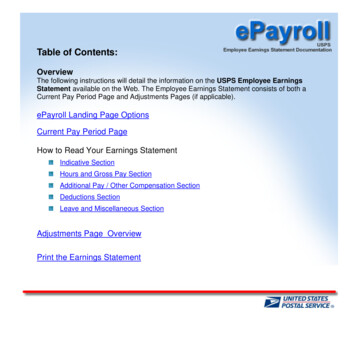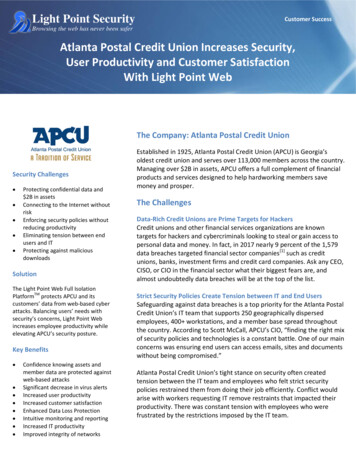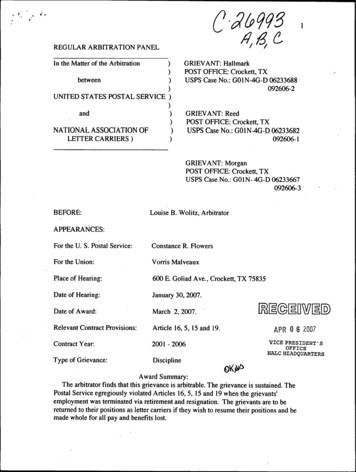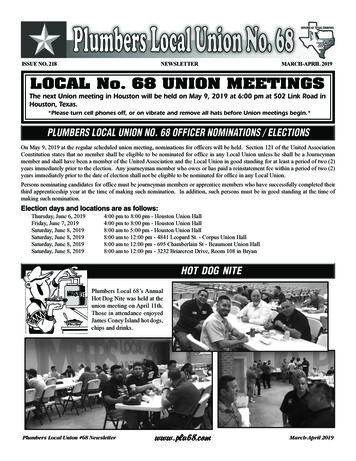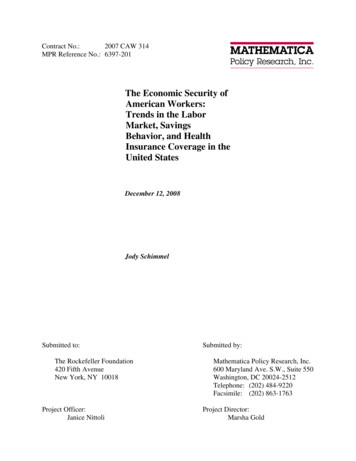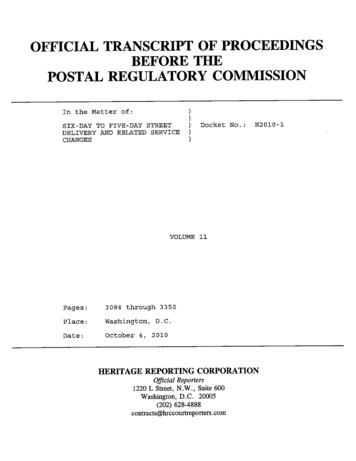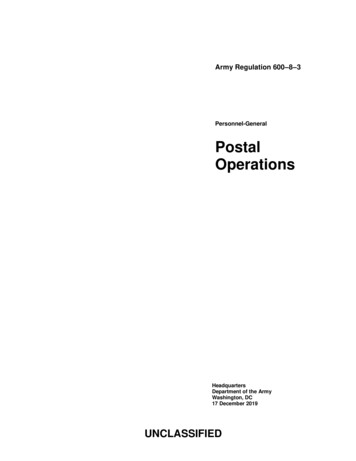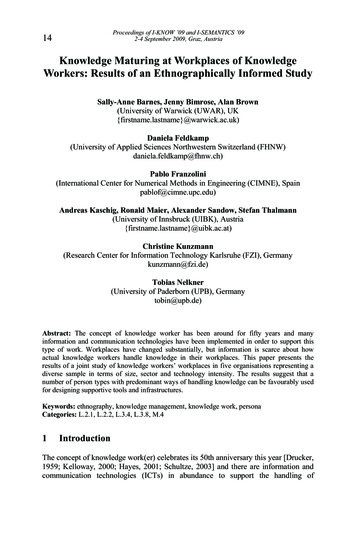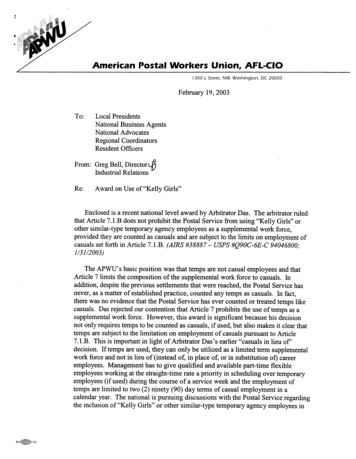
Transcription
American Postal Workers Union, AFL-CIO1300 L Street, NW, Washington, DC 20005February 19, 2003To:Local PresidentsNational Business AgentsNational AdvocatesRegional CoordinatorsResident OfficersFrom: Greg Bell, Directort?)Industrial RelationsRe:Award on Use of "Kelly Girls"Enclosed is a recent national level award by Arbitrator Das. The arbitrator ruledthat Article 7.1 .B does not prohibit the Postal Service from using "Kelly Girls" orother similar-type temporary agency employees as a supplemental work force,provided they are counted as casuals and are subject to the limits on employment ofcasuals set forth in Article 7.1 .B . (AIRS #38887 - USPS #Q90C-6E-C 94046800;113112003)The APWU's basic position was that temps are not casual employees and thatArticle 7 limits the composition of the supplemental work force to casuals . Inaddition, despite the previous settlements that were reached, the Postal Service hasnever, as a matter of established practice, counted any temps as casuals. In fact,there was no evidence that the Postal Service has ever counted or treated temps likecasuals. Das rejected our contention that Article ,7 prohibits the use of temps as asupplemental work force. However, this award is significant because his decisionnot only requires temps to be counted as casuals, if used, but also makes it clear thattemps are subject to the limitation on employment of casuals pursuant to Article7.1 .B . This is important in light of Arbitrator Das's earlier "casuals in lieu of"decision . If temps are used, they can only be utilized as a limited term supplementalwork force and not in lieu of (instead of, in place of, or in substitution of) careeremployees. Management has to give qualified and available part-time flexibleemployees working at the straight-time rate a priority in scheduling aver temporaryemployees (if used) during the course of a service week and the employment oftemps are limited to two (2) ninety (90) day terms of casual employment in acalendar year . The national is pursuing discussions with the Postal Service regardingthe inclusion of "Kelly Girls" or other similar-type temporary agency employees in 53
the same or similar reporting procedures as casuals to ensure compliance withlimitations provided for in Article 7.1 .B .BACKGROUNDThis case arose when a Step 4 grievance was filed on May 18, 1994. Thegrievance indicated that the union interpreted the contract as prohibiting the use ofemployees of temporary agencies to perform bargaining unit work. The PostalService thereafter denied the grievance, asserting in part that "'[p]revious agreementsbetween the Postal Service and the APWtJ clearly indicate that the Postal Servicemay use temporary employees to perform short-term work as long as suchemployees are considered as casual employees pursuant to Article 7.1 .B ."' Beforethis Step 4 grievance was filed, the parties had entered into two Step 4 agreements onthe issue of Kelly Girls relating to specific circumstances. Each one of thesesettlements indicated that the "'use of temporary employees (i.e., Kelly Girls) in thecircumstances described in this case shall be considered as casuals pursuant toArticle 7.2.B of the National Agreement [currently Article 7.1 .B of the NationalAgreement] ."' In addition, there was correspondence at the national level betweenthe APWU and Postal Service on several occasions relating to the use of non-careertemporary employees. In 1992, the union inquired of the Postal Service whethernon-career employees, such as "Kelly Girls" and other temporary service employees,who would operate the test Delivery Bar Code Sorters would be included within the5% authorization for the supplemental work force. The Postal Service respondedthat when such employees are used, they are to be included in the 5% contractuallimit on the supplemental work force. In 1973, the Postal Service wrote a letter tothe APWU confirming an agreement regarding use of temporary clerical support tosupplement the regular workforce of the Central Mark-Up System during conversion.The letter indicated that "'the temporary employees shall be considered as casuals inaccordance with Article VII of the National Agreement and compensated at Level 5,Step 1 except that payment far their services shall be made directly to theorganization supplying the employees."' In 1993, the APWU made an inquiryregarding the staffing of Postal Service Business Centers; i.e., "'whether theemployees of outside contractors assigned to these sites are being counted as casualemployees, for purposes of Articles 1 and 7, as we believe they must be ."'During arbitration proceedings, the union argued that temps are not casualemployees and Article 7 limits the composition of the supplemental work force tocasuals. We maintained that the term "casual" as used in the National Agreementmeans a postal employee who holds a limited-term postal appointment, is on thepostal employment rolls, and is paid directly by the Postal Service. To furthersupport this definition of casual, we cited Sections 419 and 432 of the Employee andLabor Relations Manual which describe casual employees as "'nonbargaining unit,noncareer employees with limited-term appointments ."' In addition, the unionreferred to national level arbitration decisions that have stated that the term"employed" in Article 7.1 .8 .1 means "hired ." We then argued that the temps in thiscase are not given appointments, they are paid for by an employment agency and not2
directly by the Postal Service, and they are not an the postal employment rolls . Also,the union cited testimony of a witness responsible for tracking the employment ofcasuals since 1984 that temps are not included in the casual count reports provided tothe union by the Postal Service. Therefore, we contended that if temps are notcasuals, they cannot be part of a supplemental work force that is defined in Article 7as being made up of casual employees . Accordingly, the union maintained thatArticle 7 must be read to prohibit the Service from using temps to performbargaining unit duties . Furthermore, the union asserted that prior settlements cannotbe relied on to change the limits of Article 7 since such settlements were restricted toparticular types of work or projects and particular locations . In addition, the unionargued that correspondence an the issue of temps was limited to specific factsituations and proposed specific remedies related to counting casuals. We thusmaintained that such evidence does not demonstrate an agreement by the union topermit an improper expansion of Article 7's limits . Finally, the union contended thatthe Postal Service should not be allowed to go outside negotiated limits on who canperform bargaining unit work.The Postal Service countered that there is no contract language that prohibits theuse of temps as part of the supplemental work force. While Article 7.1 .A and 7.1 .Cdefine regular work force and transitional work force employees as persons who"shall be hired pursuant to such procedures as the Employer may establish,"according to management, there is no language or requirement relating to haw casualemployees will be procured . Moreover, it asserted, the absence of a requirement thatcasuals be directly hired through the formal hiring process is consistent with thereason for a supplemental work force which is to satisfy an "immediate need byrapid availability." The Service further maintained that under Article 3, it has theright to employ nonbargaining unit personnel as deemed appropriate and nothing inArticle 7 limits this right except a limit on the period of time they can perform thework. It also argued that the union's right to object to actions involvingnonbargaining unit employees is very limited since it must establish that this conductadversely affected wages, hours or working conditions of bargaining unit employees .1n this case, the Service maintained that the union failed to rebut testimony of itswitnesses that temps are counted against the casual cap when they are used.Moreover, it asserted that the union agreed in the past that temps could be used ascasual employees as long as they are counted against the casual cap.Arbitrator Das indicated first of all that "[t]he prior settlements andcorrespondence in this record . . . fall short of establishing that the parties haveentered into an agreement on the interpretive issue raised by the Union in this case .""What the prior settlements and other correspondence do reflect," according to thearbitrator, "is that the Union has been insistent that in cases where temps have beenused by the Postal Service they are to be counted and included in the casual cap, andthe Postal Service has agreed to that ."He then observed that there is "no direct language" in Article 7 that shows thatthe Postal Service is prohibited from using temps to perform bargaining unit work as3
part of a supplemental work force. "While Article 7.13 [sic] uses the terms employee' and employment', it does not state that casual employees shall behired' by the Postal Service, as Article 7.A [sic] and 7 .C [sic] state with respect tothe regular and transitional work forces that comprise the bargaining unit," accordingto the arbitrator. Moreover, Arbitrator Das indicated that he could not rely on priornational level arbitration awards that have stated the term "employed" in Article7.1 .B .1 means "hired," since "[n]one of these prior National Arbitrator cases dealt inany way with the issue of whether casuals had to be hired as appointees and be paiddirectly by the Postal Service." In addition, he determined that definitions of casualemployees in Sections 419 and 432 of the ELM cannot be considered because theydo not cover temps who are obtained through "procurement, rather than employment,procedures ."Finally, Arbitrator Das concluded that temps should not be treated any differentlythan casuals. He said that the APWU did not assert "that use of temps as part of asupplemental work force directly relates to wages, hours or working conditions ofbargaining unit employees in any manner different from the use of casual employeesthat are hired directly by the Postal Service." Given evidence that the union'sconcern in the past has centered on the casual count, according to the arbitrator,"[t]he Union has not shown that assignment of bargaining unit work to temps, ratherthan to casuals hired directly by the Postal Service, has any additional adverse effecton the bargaining unit, provided, of course, that the temps are counted as casuals andare subject to the limits on employment of casuals set forth in Article 7.13 [sic] ."GB/djfOPEN#2AFL-CIO4
National Arbitration PanelIn the Matter of ArbitrationbetweenCase No .United States Postal ServiceQ90C-6E-C 94046800and(Kelly Girls/Casuals)American Postal Workers UnionBefore :Shyam DasAppearances :Far the Postal Service :Courtney B . Wheeler,EsquireFor the APWU :Melinda K . Holmes, EsquirePlace of Hearing :Washington,D .C .Dates o Hearing :March 26, 2002May 15, 2002Date of Final Award :January 31, 2003Relevant Contract Provision :Article 7Contract Year :199p-1994Type of Grievance :Contract Interpretation
2Q90C-6E-C 94 46800Award SummaryArticle 7 .8 does not prohibit the PostalService from using "Kelly Girls" or othersimilar-type temporary agency employees("temps") as a supplemental work force,provided they are counted as -casuals and aresubject to the limits an employment ofcasuals set forth in Article 7 .B .417LStryamas, Arbitrator
BACKGROUNDQ90C-6E-C 9446 00This case involves a grievance filed in Step 4 on May18,1994 under the 1990-1994 National Agreement between the APWU(Union)and the Postal Service .The parties agree that theissue in this case is whether Article 7 of the NationalAgreement prohibits the Postal Service from using "Belly Girls"or other similar-type temporary agency employees("temps")supplemental work force .In relevant part,Article 7 .1 of the 1990-1994National Agreement provides as follows :ARTICLE 7EMPLOYEE CLASSIFICATIONSSection l .Definition and UseA.Regular Work Force .The regular workfarce shall be comprised of two categoriesof employees which are as follows :1.Full-Time .Employees in this categoryshall be hired pursuant to suchprocedures as the Employer may establishand shall be assigned to regularschedules consisting of five (5) eight(8) hour days in a service week .2.Part-Time .Employees in this categoryshall be hired pursuant to suchprocedures as the Employer may establishand shall be assigned to regularschedules of less than forty (40) hoursin a service week, or shall be availableto work flexible hours as assigned bythe Employer during the course of aservice week .as a
2Q90C-6E-C 94 46800B.Supplemental Work Force .1.The supplemental work force shall beCasualcomprised of casual employees .employees are those who may be utilizedas a limited term supplemental workforce, but may not be employed in lieuof full or part-time employees .2 .During the course of a service week, theEmployer will make every effort toinsure that qualified and availablepart-time flexible employees areutilized at the straight-time rate priorto assigning such work to casuals .3 .The number of casuals who may beemployed in any period, ether thanDecember, shall not exceed 5% of thetotal number of employees covered bythis Agreement .4 .Casuals axe limited to two (2) ninety(90) day terms of casual employment in aIra addition to suchcalendar year .employment, casuals may be reesnployedduring the Christmas period far not morethan twenty-one (21) days .C.Transitional Work Force .1 .The transitional work force shall becomprised o noncareer, bargaining unitemployees utilized to fill vacatedassignments as follows :2 .Transitional employees shall be hiredpursuant to such procedures as theEmployer may establish .They will behired for a term not to exceed 360calendar days for teach appointment . . . .
3On March 10,Q90C-6E-C 94 468001994, APWU Executive Vice PresidentWilliam Burros sent the following letter to Postal ServiceManager Anthony Vegliante :By exchange of previous correspondencebetween the parties, I had assumed that theissue of using employees from temporaryagencies to perform bargaining unit work hadbeen resolved .Recently, Z received severalreports that the problem has not abated .The union interprets the contract asprohibiting the use of employees oftemporary agencies to perform bargainingunit work .The Supplemental Work Forceagreed to by the parties is limited toCasuals and Transitional employees .Thisinquiry is not intended to address thesubject of hiring temporary agency employeesas TEs or Casuals as other issues would beinvolved, including rate of pay and hiringprocedures etc .This is to request the employer'sinterpretation as to the use of "KellyGirls" or other employees of temporaryagencies to perform bargaining unit work .On May 12,1994, Manager William Downer responded toBurros as follows :Pursuant to the enclosed June 28, 1989, step4 settlement, temporary employees (i .e .,Kelly Girls) may be used to perform shortterm work and shall be considered as casualemployees pursuant to Article 7 .2 .B of theNational Agreement .
4The referenced June 28,Q90C-6E-C 94 468001989 grievance settlement(Case No .H7C-NA-C 35), executed by Burrus and Postal Service representativeSamuel Pulcrana, states as follows :The issue in this grievance is whether theuse of "Kelly Girls" to perform the shortterm work during the acceptance test periodof the Multi-Line Optical Character Reader(MLOCR) retry fit at the Suburban Marylandfacility was a violation of the NationalAgreement .During our discussion, we mutually agreedthat the use of temporary employees (ie .,Kelly Girls) in the circumstances describedin this case shall be considered as casualspursuant to Article 7 .2 .B of the NationalAgreement .Accordingly, we agreed to settlethis case .On May 18,1994, Burrus initiated the presentgrievance in a letter to Dowses,in which he stated :The referenced 6-28-89 grievance wasintended to resolve a specific factsituation and was not intended to interpretArticle 7 .2 .B o the National Agreement .The settlement, by its specific teems, doesnot represent the position of the union onthe use of "Temporary Agency" employees toperform bargaining unit work .The union interprets the contract asprohibiting the use of employees oftemporary agencies to perform bargainingAll bargaining unit work mush beunit work .assigned to bargaining unit employees,
5Q90C-6E-C 94 46800excluding the exceptions recognized byArticle 1 .6 and Article 32 .The Postal Service denied the grievance in a letterdated January 24, 1995, which states :The issue in this grievance is whethermanagement is in violation of the NationalAgreement whenever "temporary agencyemployees" are used to perform bargainingunit work .The Union contends that the NationalAgreement prohibits the use of employees oftemporary agencies to perform bargainingunit work .It is the position of the Postal Servicethat the use of such employees is permittedunder the terms of Article 7 .Previousagreements between the Postal Service andthe APWU clearly indicate that the PostalService may use temporary employees toperform short-term work as long as suchemployees are considered as casual employeespursuant to Article 7 .1 .B .In addition, the APWU has previously statedits position in correspondence to SherryCagnoli, Assistant Postmaster General, fromWilliam Burrus, Executive Vice President,APWU, dated May 27, 1992 .That letterstated, in part :I have been made aware of a number ofoccasions when the Postal Service hasemployed non-career employees, including"Kelly Girls" and other temporaryservice employees .
6Q90C-6E-C 94 46800The Union interprets Article 7 of theNational Agreement as limiting the rightof the Postal Service to employ noncareer employees .All non-careeremployees (Transitional employeesexcepted) are governed by the terms ofthe supplemental work force, includingthe 5 total number that can beemployed .The postal service agrees with the Union'sposition, as clearly stated in that letter,that temporary agency employees may be usedon a short-term basis as long as theme areconsidered as part of the supplemental workforce .It is also the Postal Service's positionthat employees of temporary agencies may beutilized in accordance with the provisionsof Article 32, and in such cases, they arenot considered as casual employees pursuantto Article ? .1 .BThe May 27,Union notes,1992 letter from Burrus to Cagnoli,theis only partially quoted in the Postal Service'sStep 4 decision .That letter also included the followingparagraphsThis is to inquire as to the USPS'interpretation of the National Agreementregarding the right to employ a supplementalwork force .The union was recently notifiedof your intent to employ non-careeremployees to operate the test Delivery BarCode Sorters (DBCS) at selected sites .Iinquired of Mike Guzzo whether or not thePostal Service intended to include theemployees utilized within the 5%authorization far the supplemental work
7990C-6E-C 94 46800force .To date, I have not received aresponse .Cagnali's July 14, 1992 response to this letter stated :It is the position of the Postal Servicethat when such employees ire used to operateDelivery Bar Code Sorters daring testing,those employees are to be included in the 5percent contractual limit on thesupplemental work farce .Several other pieces of correspondence between theparties relating to the Postal Service's use of temps were putinto evidence in this case, including :"A May 21,1973 letter from Senior Assistant Postmaster GeneralDarnel Brown to APWU President Francis Filbey,which states ;This letter confirms the agreement betweenthe American Postal Workers Union and theU . S . Postal Service regarding staffing ofthe Central Mark-up System duringconversion .Management shall fallow theprovisions listed below regarding suchstaffing during the conversion phase of thesystem .l.Determine if qualified employees can bedetailed td the central mark-up functionconsistent with the terms and conditionsof the national Agreement .2.After such determination, managementshall utilize such qualified employeesand, if necessary, arrange for temporaryclerical support to supplement the
8Q90C-6E-C 94 46800regular work force during the conversionphase .Although such arrangements maybe made with organizations such as KellyGirls, Inc ., or other similarorganizations, the temporary employeesshall be considered as casuals inaccordance with Article VII of theNational Agreement and compensated atLevel 5, Step 1 except that payment fortheir services shall be made directly tothe organization supplying theemployees .3 ."Post and fill permanent mark-up systempositions as soon as possible afterminimum staffing requirements have beendetermined .A December 5,1990 agreement between Clerk Craft AssistantDirector Cliff Guffey and Postal Service representative JoyceOng remanding a grievance from Step 4 on the following basis :The issue in this grievance is whethermanagement violated the National Agreementwhen temporary employees were hired toperform data input in the AIS office .After reviewing this matter, we mutuallyagreed that no national interpretive issueDuringis fairly presented in this case .our discussion, we mutually agreed that thiscase will be remanded to the local level forapplication of the settlement in Case No .H7C-NA-C 35 which states, in part :During our discussion, we mutuallyagreed that the use of temporaryemployees (ie ., Kelly Girls) in thecircumstances described in this caseshall be considered as casuals pursuant
9Q90C-6E-C 94 46800to Article 7 .2 .B of the NationalAgreement .Accordingly, we agreed to remand this caseto the parties at Step 3 far furtherprocessing, including arbitration,ifnecessary . . . ."A November 12,1993 letter from APWU President Moe Biller toPostal Service Vice President Joseph Mahon,Jr ., which states :This is an inquiry and a statement ofposition by the American Postal WorkersUnion concerning the staffing of PostalService Business Centers . . . .These sitesaxe staffed by substantial numbers ofemployees employed by outside contractors,and by Postal Service employees assigned toEAS positions called "Customer ServiceRepresentative, Expedited ServiceSpecialist," or "Mailpiece Design Analyst ."Our inquiry is whether the employees ofoutside contractors assigned to these sitesare being counted as casual employees, forpurposes of Articles 1 and 7, as we believethey must be .If they are being counted ascasuals, please provide the Union withdocumentation or other evidence of that factwhich will permit the Union to ensurecontinuing compliance with that requirement .Our statement of position is that theemployees in the three EAS positions listedabove are performing duty assignments whichshould be assigned to the bargaining unit .Please state whether or not the PostalService will assign this work to bargainingunit employees .
10According to the Union,Q90C-6E-C 94 46800the situation described in this lettersubsequently became the subject of a separate grievance .UNION POSITIONThe Union initially states that it is not challengingin this case how the Postal Service hires casuals or comes toemploy any ether category of workers .Its basic position isthat temps are not casual. employees and that Article ? limitsthe composition of the supplemental work force to casuals .The Union asserts that the term "casual" as used inthe National Agreement means a postal employee who holds alimited-term postal appointment,is on pastel employment rolls,and is paid directly by the Postal Service .who is a"casual" is themeaning the parties always haveapplied to that term in Article 7 .Union states,This definition ofIt also is supported, theby Sections 419 and 432 of the ELM,"casual employees" as "'nonbargaining unit,with limited-term appointments" .which describenoncareer employeesNational Arbitration decisionsalso have recognized and used this definition,and haveestablished . that the term "employed" in Article 7 .1 .8 .1 means"hired" .The Union points out that the temps at issue in thiscase do not enjoy any of the qualities that undisputedly definea casual .They do not have appointments,they are paid by anemployment agency and not directly by the Postal Service,andthey do not show up anywhere on postal employment rolls .Ast
11Q90C-6E-C 94 46800testified to by Union witness Phil Tabbita, who has beentracking the employment of casuals since 1984, temps are notincluded in the casual count reports provided to the Union on aregular basis by the Postal Service .The Union contends that if temps are not casuals,which undisputedly they are not,then they cannot be part of asupplemental work force defined in Article 7 as being made up ofonly casual employees .The Union further argues that Article 7describes the only categories of workers who can work within theAP'WU bargaining unit -- the regular work force,work force and the transitional work force .the supplementalThere is no issuehere that temps fit into the regular or transitional work force,and the evidence demonstrates they do not fit into thesupplemental work force .Therefore,the Union insists, Article7 must be read to prohibit the Postal Service from using tempsto perform bargaining unit duties .The Union maintains that the Postal Service's argumentthat Article 7 .1 .B does not require that casuals be "hired" is anew argument .As such it should not be entertained by theArbitrator under National Arbitration precedent .In any event,the Postal Service has presented no evidence to contradict thedefinition of casuals established by the Union which includesthe fact that casuals are hired .from the ELM,decisions .This is clear,the Union says,the National Agreement and past arbitral
fx12Q90C-6E-C 94 46800The Union also points out that although the PostalService's Step 4 position makes brief mention of Article 32,theparties have not joined issue on the interpretation andapplication of Article 32 or .Article 1 to the temps described inthis case .The Union argues that prior remedial settlementsrelied on by the Postal Service did not change the limits ofArticle 7 .In the case of each of the three cited settlements -- Filbey/Brown(1990)(19?3) ; Burrus/Pulcrano(1989)and Guffey/Ong-- the parties explicitly described a type of work orproject and a particular location to which they worked out aremedy for the Postal Service's impermissible use of temps inthe supplemental work force .Bath the Burrus/Pulcrano andGuffey/Ong settlements resolved grievances over the use of tempswhich had already ended .stresses,By their very terms,the Unionnone of these settlements can be read to have modifiedArticle ?oThe Union insists that the Postal Service has providedno substantiation for its claim that these settlementsimplicitly changed the rule of Article ? to allow the PostalService to use temps so long as it treats them like casuals .Moreover,the Postal Service has not actually treated temps likecasuals .Despite the settlements that were reached,Service has never,the Postalas a matter of established practice,any temps as casuals .counted
313Q90C-6E-C 94 46800The Union also maintains that the Burrus/Cagnoli(1992)and Billar/Mahon(1973)correspondence cited by thePostal Service were limited to specific fact situations .the 1989 Burrus/Pulcrano grievance settlement,most proposed,Article 7,Likethese letters atas a resolution to an obvious violation ofa remedy whereby the temps would be counted ascasuals .The Union asserts that its willingness to negotiateremedies to violations of Article 7 in the past does notobligate the APWU to similar future agreements or demonstrate anagreement to allow the Postal Service unfettered opportunity touse temps within the supplemental work force .Permitting anexpansion of Article ? contrary to its express terms,argues,the Unionundermines the protections limiting the supplementalwork force that the APWL1 has negotiated over many years .Finally,the Union insists that it is not sufficientor permissible for the Arbitrator to rewrite the NationalAgreement to include temps in the definition of casuals or torequire that they be treated like casuals,allay the Union's concerns .or both,in order toNot only has the Postal Service notcomplied in even limited circumstances with treating temps ascasuals, but the overarching issue in this case is aboutnegotiated limits an who can perform bargaining unit work otherthan the career employees represented by the Union .
14Q90C-6E-C 94 46800EMPLOYER POSITIONThe Postal Service asserts that in addition to hiringemployees,it has used contract employees,including temps,first collective bargaining agreement .since before the parties'Temps have bean used as part of a supplemental work force toperform both bargaining unit and nonbargaininq unit workgenerally in situations when a specialized skill has been neededor if the Postal Service has difficulty recruiting appointees .Contract employees are obtained under the Procurement Manual,incontrast to those casual employees who axe hired as appointeesunder the provisions of the ELM cited by the Union .The Postal Service contends that there is no languagein Article 7,or elsewhere,in the National Agreement whichprohibits the use of temps as part of the supplemental workforce .It points out that while Article 7 .1 .A and ? .1 .Cspecifically define regular work force anti transitional workforce employees as persons who"shall be hired pursuant to sodaprocedures as the Employer may establish",there is no suchlanguage or requirement in Article 7 .1 .B relating to asupplemental . work force comprised of casual. employees .Article7 does not address haw such employees will be procured nor doesit even remotely imply that casual workers need be an postalrolls .The Postal Service argues that the glaring absence ofany requirement that cas
American Postal Workers Union, AFL-CIO 1300 L Street, NW, Washington, DC 20005 February 19, 2003 To: Local Presidents National Business Agents National Advocates Regional Coordinators Resident Officers From: Greg Bell, Directort?) Industrial Relations Re: Award on Use of "Kelly Girls" Enc
